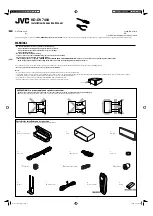
Making Administrator
Password Settings
1.
Select
"Password Settings"
and press
[ENTER]
.
•
The password settings screen is displayed.
2.
Use
[
][
]
to select the following items and enter
a password (4–10 digits):
"Current password"
: Enter the current password
(default: 00000000).
"New password"
: Enter the new password.
"Retype new password"
: Enter the new password
again.
Note
•
Please change the default login password
the first time the unit is installed.
•
Be sure to keep the password safe.
3.
Press
[G]
.
•
A dialogue box to confirm the changing of
settings is displayed.
4.
Use
[
][
]
to select
"Yes"
and press
[ENTER]
.
•
The administrator menu screen is displayed.
Making Encryption Settings
Note
•
For 2-party video conference calls, a
connection cannot be made if the two party’s
settings for communication encryption do not
match. However, when communication is
performed using H.323, and either site has
"Best effort"
set for
"Encryption (H.323)"
, a
connection can be made even if the sites’
communication encryption settings are not the
same. For multiple-party video conference
calls, the ability for the Main Site to connect to
Sub Sites is determined the same way as for
2-party video conference calls.
•
Be careful when changing encryption settings
because doing so may cause you to become
unable to communicate with other parties.
•
There is a danger that encryption settings will
be changed by a third party. Therefore, be
careful when managing the administrator
password and giving users the authority to
change encryption settings.
•
If an encryption key is not set for SIP
communication, you cannot enable encryption.
•
When using encrypted communication with the
KX-VC Series NAT Traversal Service, set SIP
communication encryption using this setting.
When using IP/NAT traversal mode, use the
same encryption settings as for SIP
communication in IP mode or NAT traversal
mode.
•
Be aware that if encryption is disabled,
eavesdropping might be possible on networks
that are not secured against such actions.
1.
Select
"Encryption"
and press
[ENTER]
.
•
The encryption settings screen is displayed.
2.
Use
[
][
]
to select the following items for input:
Note
•
When using IP mode:
–
When
"SIP"
is set to
"OFF"
on the call
type settings screen (Page 123),
"Access mode (SIP)"
,
"Encryption
(SIP)"
and
"Encryption Key (SIP)"
cannot be set.
–
When
"H.323"
is set to
"OFF"
on the
call type settings screen (Page 123),
"Access mode (H.323)"
and
"Encryption (H.323)"
cannot be set.
–
"Access mode (NAT Traversal)"
and
"Encryption (NAT Traversal)"
cannot
be set.
•
When using NAT Traversal mode:
–
"Access mode (SIP)"
,
"Encryption
(SIP)"
,
"Access mode (H.323)"
, and
"Encryption (H.323)"
cannot be set.
•
When using IP/NAT Traversal mode:
–
When
"H.323"
is set to
"OFF"
on the
call type settings screen (Page 123),
"Access mode (H.323)"
and
"Encryption (H.323)"
cannot be set.
"Access mode (SIP)"
/
"Access mode (NAT
Traversal)"
/
"Access mode (H.323)"
: Use
[
]
[
]
to select
"Admin"
(default) or
"User"
.
•
When
"Admin"
is selected, only the network
administrator can enable/disable encryption.
•
When
"User"
is selected, any users can
enable/disable encryption (Page 106,
Page 106).
"Encryption (SIP)"
/
"Encryption (NAT
Traversal)"
: Use
[
][
]
to select whether to
enable encryption.
–
"ON"
: Encryption is enabled.
120
User Manual
Document Version 2015-08
Contacts and Settings
















































